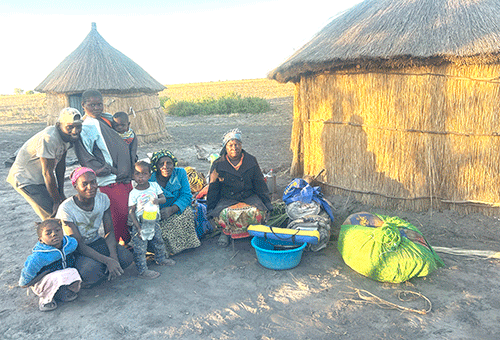OLD MASOKOTWANI – On a chilly Saturday afternoon, an elderly woman and her children, including a toddler as young as two, leave their home behind and embark on a journey into the thick velds of Old Masokotwani to harvest thatch grass for survival.
Accompanied by their dog for protection, the woman takes advantage of the school holidays, and goes with her children to assist with harvesting and packing the local grass used in constructing thatch roofs that have become popular, especially among upmarket housing developments.
Due to a lack of transport, they carry their belongings – bedding, food and cooking utensils – on their heads over 10km to camp closer to the grass fields for nearly three weeks to cut as many bundles as possible.
Crarina Komba, in her mid-50s, is from Mukwake village in Masokotwani, Zambezi region.
Survival camp
She said due to poverty and the prevailing drought situation which has gripped the nation, she decided not to lie idle at home, but to capitalise on the thatch grass business to put food on the table for her family.
“We come here with our belongings to camp for weeks so that we cut grass to make a living and sustain our families. We sell the thatch grass to get an income to buy food, as we got nothing from our crop fields this year due to drought. We also get some money to pay school fees and buy uniforms for our kids. We are unemployed, and don’t want to lie idle at home doing nothing,” Komba reiterated.
She sells her thatched grass for N$20 per bundle, which Komba and other thatchers place alongside the main roads for easy access by potential buyers.
She said they take along the maize meal they receive from the government as drought relief food while camping. However, one of the challenges when it comes to relish is that they only rely on communal farmers in the area to buy sour milk.
As an old saying goes, “nothing worth having comes easy,” she said, before noting that thatching grass is a dangerous expedition.
“We go with our kids in the fields when cutting grass, and it’s dangerous as there are deadly snakes. We also face the challenge of wild animals such as buffaloes and elephants. However, we have to take the risk, as we have to make a living to survive and support our families,” she said bravely.
Once camping in the fields, they rely on available water wells dug by farmers to draw water for drinking, cooking and bathing.
During the months of April to September, many residents of Zambezi profit from the thatch grass trade, as it has over the years contributed considerably to the household economies of rural people in the region.
Komba shares with New Era that thatch grass is an important means of subsistence for thousands of residents, especially in rural areas, as it is commonly used to construct houses and lodges in thatched form.
She said their customers are mainly lodge owners, fellow villagers and any Namibian or foreign nationals who wish to buy and construct a thatched roof house, or build lapas.
Thatchers
The region of Zambezi has thousands of thatched houses in villages and towns. Situated in the north-east of Namibia, Zambezi is home to a thriving community of thatchers who have been preserving this ancient art for decades.
Traditionally, residents take part in thatching activities, and there are several cafes, lodges, restaurants, museums and places to stay with thatched roofs.
Katima Rural Constituency councillor Warden Simushi confirmed the practice.
“It has been a culture for years for inhabitants to generate funds, instead of relying on government handouts. The harvesting season starts in April and ends in September for the purpose of building houses. Some people prefer grass to thatch, which makes their houses cooler during the summer and warmer during the winter.
They feel the comfort of life,” he noted.
The councillor said residents sell the grass for commercial purposes to anyone who wishes to build lodges, campsites and bigger thatched houses.
Simushi encouraged locals who are doing nothing to venture into the trade of harvesting thatch grass and generate an income, instead of waiting for government handouts.
“It’s a source of income, as people can buy school items for kids and food for their families. I am urging the entire region where there is grass to embark on this income-generating trade of harvesting thatch grass,” he urged.
Livelihood
Meanwhile, Kanono senior Induna (headman) Bothman Sikute was impressed.
“Poor and unemployed people go and harvest grass, which they sell and make money. Many people didn’t get any harvest from their crop fields, so they survived by cutting grass and selling it alongside the main roads to get money to buy clothes, food and pay school fees for their children, as well as stationery. They also use it to thatch their houses in the villages,” Sikute observed.
– anakale@nepc.com.na


